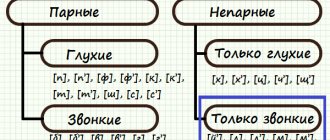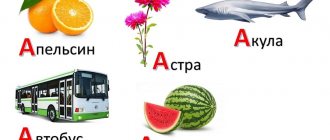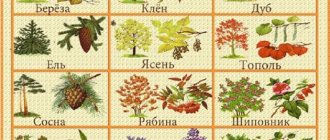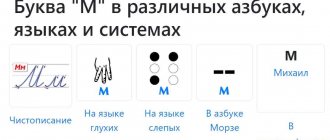§6. Hard and soft consonants
Consonants differ not only in deafness and voicedness, but also in hardness and softness. Hardness softness is the second most important feature of consonants in the Russian language.
Soft consonants differ from hard consonants in the special position of the tongue. When pronouncing hard words, the entire body of the tongue is pulled back, and when pronouncing soft words, it is moved forward, and the middle part of the tongue is raised. Compare: [m] – [m'], [z] – [z']. Voiced soft ones sound higher than hard ones.
Many Russian consonants form pairs based on hardness and softness : [b] - [b'], [v] - [v'] and others. There are 15 such pairs.
Hardness-softness pairs: [b] and [b'], [m] and [m'], [p] and [p'], [v] and [v'], [f] and [f'] , [z] and [z'], [s] and [s'], [d] and [d'], [t] and [t'], [n] and [n'], [l] and [l'], [p] and [p'], [k] and [k'], [g] and [g'], [x] and [x'].
But there are sounds that do not have a pair on the basis of hardness and softness. For example, the sounds [zh], [sh], [ts] do not have a soft pair, but [y'] and [h'] do not have a hard pair.
Unpaired in hardness-softness
Solid unpaired : [f], [w], [c].
Soft unpaired : [th'], [h'], [w':].
§7. Indication of softness of consonants in writing
Let's take a break from pure phonetics. Let's consider a practically important question: how is the softness of consonants indicated in writing?
There are 36 consonant sounds in the Russian language, including 15 hard-soft pairs, 3 unpaired hard and 3 unpaired soft consonants. There are only 21 consonants. How can 21 letters represent 36 sounds?
Various methods are used for this:
- iotized letters e, e, yu, i after consonants, except sh, zh and c, unpaired in hardness-softness, indicate that these consonants are soft, for example: aunt - [t'o´t'a], uncle - [Yes Yes];
- letter and after consonants, except sh, zh and c. The consonants denoted by the letters sh, zh and c are unpaired hard. Examples of words with the vowel letter and: ni´tki - [n'i´tk'i], leaf - [l'ist], cute - [m'i´lyy'];
- the letter ь, after consonants, except sh, zh, after which the soft sign is an indicator of the grammatical form. Examples of words with a soft sign: request - [proz'ba], stranded - [m'el'], distance - [dal'].
Thus, the softness of consonants in writing is conveyed not by special letters, but by combinations of consonant letters with the letters i, e, e, yu, i and ь. Therefore, when parsing, I advise you to pay special attention to adjacent letters after the consonants.
Discussing the problem of interpretation
School textbooks say that [w] and [w'] are unpaired in hardness and softness. How so? We hear that the sound [w'] is a soft analogue of the sound [w]. When I was studying at school myself, I couldn’t understand why? Then my son went to school. He had the same question. It appears in all children who approach learning thoughtfully.
Confusion arises because school textbooks do not take into account that the sound [w'] is also long, but the hard sound [sh] is not. Pairs are sounds that differ in only one attribute. And [w] and [w'] - two. Therefore [w] and [w'] are not pairs.
For adults and high school students.
In order to maintain correctness, it is necessary to change the school tradition of transcribing the sound [w']. It seems that it is easier for the guys to use one more additional sign than to face an illogical, unclear and misleading statement. It's simple. So that generation after generation does not rack their brains, it is necessary to finally show that a soft hissing sound is long.
For this purpose, in linguistic practice there are two icons:
1) superscript above the sound; 2) colon.
Using a superscript is inconvenient because it is not provided by the set of characters that can be used in computer typing. This means that the following possibilities remain: using a colon [w':] or a grapheme denoting the letter [w']. It seems to me that the first option is preferable. Firstly, children often mix sounds and letters at first. The use of a letter in transcription will create the basis for such confusion and provoke an error. Secondly, children are now starting to learn foreign languages early. And the [:] symbol, when used to indicate the length of a sound, is already familiar to them. Thirdly, transcription indicating longitude with a colon [:] will perfectly convey the features of the sound. [sh':] - soft and long, both features that make up its difference from the sound [sh] are presented clearly, simply and unambiguously.
What advice can you give to children who are now studying using generally accepted textbooks? You need to understand, comprehend, and then remember that in fact the sounds [w] and [w':] do not form a pair in terms of hardness and softness. And I advise you to transcribe them the way your teacher requires.
§5. Voiced and voiceless consonants
According to the ratio of noise and voice, consonants are divided into voiced and voiceless . When pronouncing voiced consonants, both voice and noise are heard, while voiceless consonants hear only noise. Deaf words cannot be spoken loudly. They cannot be shouted.
Let's compare the words: house and cat. Each word has 1 vowel sound and 2 consonants. The vowels are the same, but the consonants are different: [d] and [m] are voiced, and [k] and [t] are voiceless. Voicedness-voicelessness is the most important feature of consonants in the Russian language.
Many Russian consonants form pairs based on voicedness-voicelessness: [b] - [p], [z] - [c] and others. There are 11 such pairs.
Voiceless-voiced pairs: [p] and [b], [p'] and [b'], [f] and [v], [f'] and [v'], [k] and [g], [k'] and [g'], [t] and [d], [t'] and [d'], [w] and [g], [s] and [z], [s'] and [ z'].
But there are sounds that do not have a pair on the basis of voicedness - deafness. For example, the sounds [r], [l], [n], [m], [y'] do not have a voiceless pair, but [ts] and [ch'] do not have a voiced pair.
Unpaired according to deafness-voicing
Voiced unpaired: [р], [л], [н], [м], [й'], [р'], [л'], [н'], [м']. They are also called sonorous .
What does this term mean? This is a group of consonants (9 in total) that have peculiarities of pronunciation: when they are pronounced, obstacles also arise in the oral cavity, but such that the air stream passing through the obstacle creates only a slight noise; air passes freely through an opening in the nasal or oral cavity. Sonorants are pronounced using the voice with the addition of slight noise. Many teachers do not use this term, but everyone should know that these sounds are unpaired voiced sounds.
Sonorants have two important features:
1) they are not deafened, like paired voiced consonants, before voiceless consonants and at the end of a word;
2) before them there is no voicing of paired deaf consonants (i.e. the position in front of them is strong in deafness-voicing, just like before vowels). See below for more information on positional changes.
Voiceless unpaired: [ts], [h'], [w':], [x], [x'].
How can it be easier to remember lists of voiced and voiceless consonants?
The following phrases will help you remember lists of voiced and voiceless consonants:
Oh, we didn’t forget each other! (Here only voiced consonants)
Foka, do you want to eat some soup? (Here only voiceless consonants)
True, these phrases do not include pairs of hardness and softness. But usually people can easily figure out that not only hard [z] is voiced, but also soft [z'], not only [b], but also [b'], etc.
§10. Letters and sounds
Letters and sounds have different purposes and different natures. But these are comparable systems. Therefore, you need to know the types of ratios.
Types of relationships between letters and sounds:
- The letter denotes a sound, for example vowels after hard consonants and consonants before vowels: weather.
- The letter does not have its own sound meaning, for example ь and ъ: mouse
- The letter denotes two sounds, for example, iotated vowels e, e, yu, i in the positions:
- the beginning of a word
- after vowels,
- after the separators ь and ъ.
- A letter can denote a sound and the quality of a preceding sound, such as iotated vowels and and after soft consonants.
- A letter can denote the quality of the preceding sound, for example ь in the words shadow, stump, firing.
- Two letters can mean one sound, often a long one: sew, compress, rush
- Three letters correspond to one sound: smile - ts - [ts:]
§3. Vowels and consonants
Sounds are divided into vowels and consonants. They have different natures. They are pronounced and perceived differently, and also behave differently in speech and play different roles in it.
Vowels are sounds during the pronunciation of which air passes freely through the oral cavity without encountering an obstacle on its way. Pronunciation (articulation) is not focused in one place: the quality of the vowels is determined by the shape of the oral cavity, which acts as a resonator. When articulating vowels, the vocal cords in the larynx work. They are close, tense and vibrate. Therefore, when pronouncing vowels, we hear a voice. Vowels can be drawn out. You can shout them. And if you put your hand to your throat, you can feel the work of the vocal cords when pronouncing vowels, feel it with your hand. Vowels are the basis of a syllable; they organize it. There are as many syllables in a word as there are vowels. For example: he - 1 syllable, o-na - 2 syllables, re-bya-ta - 3 syllables, etc. There are words that consist of one vowel sound. For example, conjunctions: and, a and interjections: O!, A!, Oooh! and others.
In a word, vowels can be in stressed and unstressed syllables . A stressed syllable is one in which the vowel is pronounced clearly and appears in its basic form. In unstressed syllables, vowels are modified and pronounced differently. Changing vowels in unstressed syllables is called reduction.
There are six stressed vowels in the Russian language: [a], [o], [u], [s], [i], [e].
Remember:
There may be words that can only consist of vowels, but consonants are also necessary. In the Russian language there are many more consonants than vowels.
Soft and hard sounds in Russian.
What is the best way to explain to a child what the difference is between soft and hard sounds? It is best to start with the child understanding that hardness and softness are inherent only in consonant sounds. While we can only hum vowel sounds. Remember that hardness and softness are not characteristic of them, but they are the ones that affect the quality of the consonant sound. The properties of hard and soft sounds lie precisely in the difference in their pronunciation.
When you pronounce a consonant softly, the middle of your tongue is raised to the roof of your mouth and closes the passage through which the air flow should pass. At the same time, the tip of the tongue moves straight forward towards the teeth. This phenomenon is called palatalization.
Of course, children should not be burdened with such complex information, but parents should know this term. Please note that when we pronounce hard consonants, no palatalization occurs.
First, try to understand this difference yourself. To do this, say for example words where the same sound can be both hard and soft.
Let's try to consider the difference using the word “overgrown” as an example. Please note that when we pronounce the first sound [r'], the tongue confidently rises to the sky. But when we pronounce the second sound [r], we do not strain our tongue so much, except that we only press the tip of the tongue to the palate.
Moms and dads usually easily learn this material, but how can you explain this rule in your hands so that the child can understand it? Here all that remains is to use your imagination, look for interesting stories, simple games that will help a preschooler grasp the very difference between hard and soft sounds.
| Paired vowels by hardness/softness | Unpaired consonant sounds by hardness/softness | ||
| Solid | Soft | Only hard ones | Only soft |
| [B] | [B'] | [AND] | [H'] |
| [IN] | [IN'] | [SH] | [th'] |
| [D] | [D'] | [Ts] | [SCH'] |
| [G] | [G'] | ||
| [Z] | [Z'] | ||
| [TO] | [TO'] | ||
| [L] | [L'] | ||
| [M] | [M'] | ||
| [N] | [N'] | ||
| [P] | [P'] | ||
| [R] | [R'] | ||
| [WITH] | [WITH'] | ||
| [T] | [T'] | ||
| [F] | [F'] | ||
| [X] | [X'] | ||








